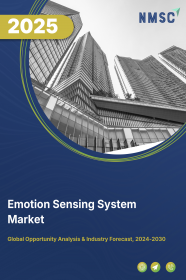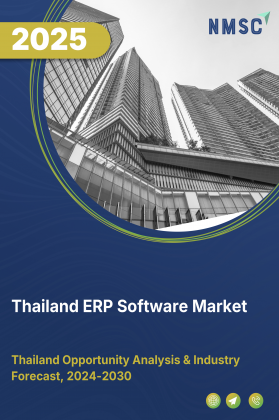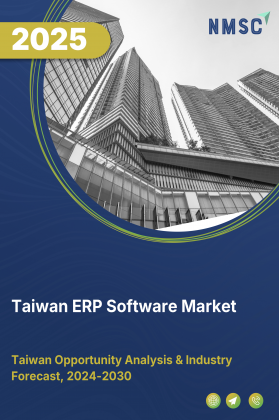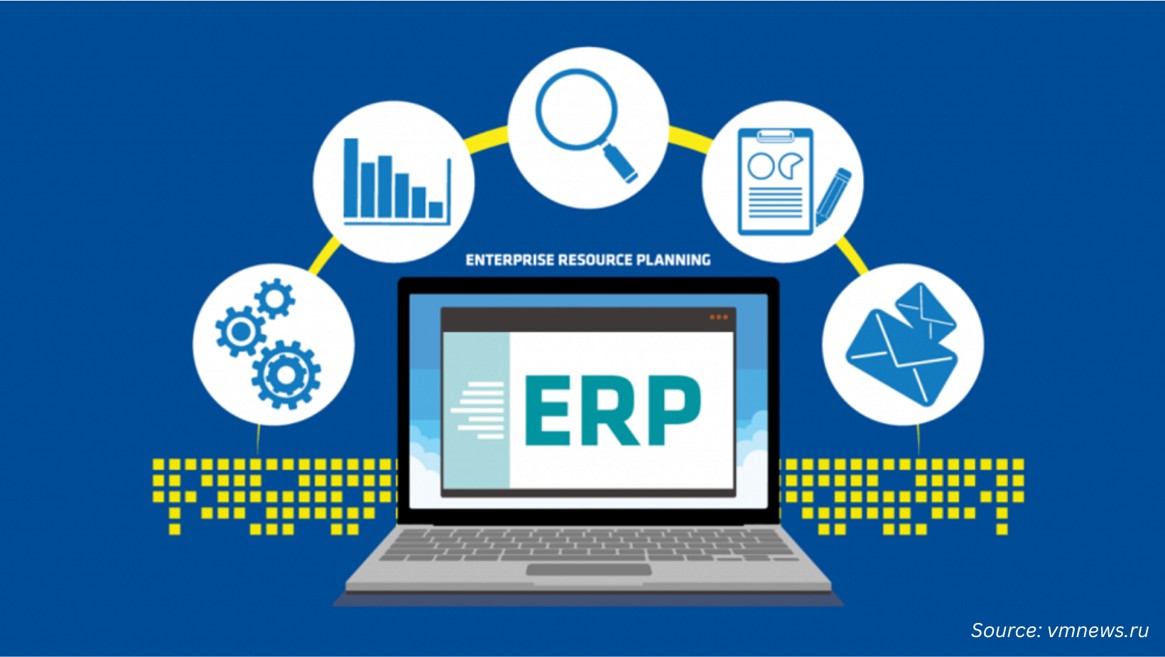
Emotion Sensing System Market by Software Tool (Facial Expression & Emotion Recognition, Gesture & Posture Recognition, and Voice Recognition), by Technology (Pattern Recognition Network, Bio Sensors, Machine Learning, Natural Language Processing, and Others), by Application (Law Enforcement Surveillance & Monitoring, Entrainment & Consumer Electronics, Marketing & Advertising, Medical Emergency, Robotics & eLearning) and Others–Global Opportunity Analysis and Industry Forecast, 2024–2030
Market Definition
The Emotion Sensing System Market size was valued at USD 19.27 billion in 2023 and is predicted to reach USD 44.78 billion by 2030 at a CAGR of 12.80% from 2024 to 2030.
The emotion sensing system is a solution or program that is frequently used to read or identify the emotions on a human face. An emotion sensing system detects or senses any of the six primary categories of emotions, such as happiness, sorrow, fear, surprise, disgust, and anger. Many industries use emotion detection technology to track customer behavior and emotions. In addition, emotion detection technology allows artificial intelligence (AI) to identify a person’s feelings from their facial expressions. The most common emotion sensing systems used in the public and private sectors is the Fourth Eye Can. This emotion sensing solution can track attendance without maintaining registers along with detecting all types of facial expressions and performing eKYC for financial institutes.
Market Dynamics and Trends
The proliferation of wearable devices equipped with emotion sensing capabilities, coupled with the growing Internet of Things (IoT) ecosystem, is driving the integration of emotion sensing technology into everyday devices. Wearables such as smartwatches and fitness trackers, as well as IoT devices in smart homes and healthcare settings, leverage emotion sensing to provide insights into user behavior and well-being, fueling market growth.
Moreover, technological advances in Natural Language Processing (NLP) are driving a surge in demand for emotion sensing systems. The evolving landscape of NLP technologies, including deep learning models and sophisticated language understanding algorithms, is enabling sentiment analysis tools to interpret human emotions with greater accuracy and nuance. Businesses, healthcare providers, and various industries are increasingly recognizing the value of understanding customer sentiments, patient emotions, and user feedback to tailor their services, improve customer experiences, and offer more empathetic interactions.
Furthermore, with a growing awareness of mental health issues, healthcare professionals are using sentiment and emotion analysis software to monitor and assess the emotional states of patients. This technology can help identify signs of anxiety, depression, or other mental health conditions through the analysis of patient communications, such as text messages, social media posts, or recorded conversations.
For instance, Opsis, a software solutions provider’s emotion analysis software with AI technology helps the counselors to diagnose seniors more accurately for mental health conditions such as anxiety, stress and depression.
However, developing and implementing emotion sensing systems require significant investments in research, development, and infrastructure. High costs associated with sensor technologies, data analytics tools, and integration with existing systems can be prohibitive for businesses, particularly small and medium-sized enterprises (SMEs), limiting market expansion.
On the other side, advancements in audio analytic technology, integrated in emotion sensing systems, which can analyze human emotion via audio recordings to detect financial fraud in real time, is expected to create ample opportunities for the emotion sensing systems market in the coming years.
Market Segmentations and Scope of the Study
The emotion sensing systems market is segmented on the basis of software tool, technology, application, end user, and geography. On the basis of software tool, the market is divided into facial expression & emotion recognition, gesture & posture recognition, and voice recognition. On the basis of technology, the market is classified into pattern recognition network, bio sensors, machine learning, natural language processing, and others. On the basis of application, the market is segmented into law enforcement surveillance & monitoring, entrainment & consumer electronics, marketing & advertising, medical emergency, robotics & eLearning, and others. On the basis of end user, the market is segmented into government, healthcare, retail, entertainment, education, media & entertainment, automotive, and others. The geographical breakdown and analysis of each of the aforesaid segments include regions comprising North America, Europe, Asia-Pacific, and Row.
Geographical Analysis
North America holds the lion share of the emotion sensing systems market and is expected to continue its dominance during the forecast period. This is attributed to the development of advanced healthcare industry in counties such as U.S. and Canada, where emotion detecting technologies such as machine learning algorithms are increasingly prevalent to analyze facial expressions and body language to detect signs of pain, anxiety, and depression in patients.
Moreover, the increasing utilization of natural language processing (NLP) for analyzing tone and sentiment, particularly in finance and legal applications is driving the demand for emotion sensing systems. For instance, in October 2022, John Snow Labs unveiled two groundbreaking products: Financial NLP and Legal NLP.
These innovative libraries are equipped with a range of new pretrained models and state-of-the-art algorithms. Capable of performing tasks such as entity recognition, relation extraction, assertion status detection, entity resolution, de-identification, and text classification, these products represent a significant advancement in the field.
This development is poised to revolutionize the finance and legal sectors by enabling organizations to glean invaluable insights, make informed decisions, and enhance operational efficiency, thereby driving robust market growth in North America.
Also, the prevalence of automotive industry in the region has increased the adoption of emotion sensing technology, named Driver monitoring systems (DMS) in cars such as Ford, Chevrolet, and Tesla, to monitor the emotional states of drivers to improve safety and comfort.
This includes monitoring driver’s facial expressions and body language to detect signs of drowsiness or distraction. For instance, Tesla successfully installed driver monitoring systems (DMS) in Model 3 and Model Y cars with a cabin camera. This is expected to boost the growth of the emotion sensing system market in the region.
On the other hand, Asia–Pacific is expected to show a steady rise in the emotion sensing system market due to the prevalence of automotive industry in the region, that has adopted the emotion sensing technology, named Driver monitoring systems (DMS) in cars such as Ford, Chevrolet, and Tesla.
This system monitors the emotional states of drivers to improve safety and comfort. This includes monitoring driver’s facial expressions and body language to detect signs of drowsiness or distraction. For instance, Tesla successfully installed driver monitoring systems (DMS) in Model 3 and Model Y cars with a cabin camera. This is expected to boost the growth of the emotion sensing system market in the region.
Competitive Landscape
The market players operating in the emotion sensing system market include Smart Eye, Apple Inc., Nemesysco, Eyeris Technologies Inc., Kairos AR Inc., Noldus Information Technology, Realeyes, Sentiance NV, Sightcorp BV, and SkyBiometry. These market players continue to adopt various market development strategies including new launches to maintain their dominance in the emotion sensing system market.
For instance, in January 2024, Smart Eye unveiled its ground-breaking innovations at CES 2024 in Las Vegas. The company showcased the latest advancements in its road-ready automotive solutions, such as a vehicle buck featuring its award-winning Interior Sensing AI and Driver Monitoring System (DMS) software.
Moreover, in March 2022, Nemesysco announced to launch a new voice analytics company called Emotion Logic. Through this launch, the company aims to use artificial intelligence (AI) to detect and measure human emotions and improve automated communications and interactions in metaverse worlds.
Key Benefits
-
The emotion sensing systems market report provides the quantitative analysis of the current market and estimations from 2024 to 2030. This analysis help identify the prevailing market opportunities to capitalize on.
-
The study comprises a detailed analysis of the emotion sensing systems market trends including the current and future trends for depicting the prevalent investment pockets in the market.
-
The information related to key drivers, restraints, and opportunities and their impact on the emotion sensing systems market is provided in the report.
-
The competitive analysis of the market players along with their market share in the emotion sensing systems market is mentioned.
-
The SWOT analysis and Porter’s Five Forces model are elaborated in the study.
-
The value chain analysis in the market study provides a clear picture of the stakeholders’ roles.
Key Market Segments
By Software Tool
-
Facial Expression and Emotion Recognition
-
Gesture and Posture Recognition
-
Voice Recognition
By Technology
-
Pattern Recognition Network
-
Bio Sensors
-
Machine Learning
-
Natural Language Processing
-
Others
By Application
-
Law Enforcement Surveillance & Monitoring
-
Entrainment & Consumer Electronics
-
Marketing & Advertising
-
Medical Emergency
-
Robotics & eLearning
-
Others
By End-User
-
Government
-
Healthcare
-
Retail & E-Commerce
-
Education
-
Media & Entertainment
-
Automotive
-
Others
By Region
-
North America
-
The U.S
-
Canada
-
Mexico
-
-
Europe
-
The UK
-
Germany
-
France
-
Italy
-
Spain
-
Denmark
-
Netherlands
-
Finland
-
Sweden
-
Norway
-
Russia
-
Rest of Europe
-
-
Asia-Pacific
-
China
-
Japan
-
India
-
South Korea
-
Australia
-
Indonesia
-
Singapore
-
Taiwan
-
Thailand
-
Rest of Asia-Pacific
-
-
Rest of World (RoW)
-
Latin America
-
Middle East
-
Africa
-
REPORT SCOPE AND SEGMENTATION:
|
Parameters |
Details |
|
Market Size in 2023 |
USD 19.27 Billion |
|
Revenue Forecast in 2030 |
USD 44.78 Billion |
|
Growth Rate |
CAGR of 12.80 from 2024 to 2030 |
|
Analysis Period |
2023–2030 |
|
Base Year Considered |
2023 |
|
Forecast Period |
2024–2030 |
|
Market Size Estimation |
Billion (USD) |
|
Growth Factors |
|
|
Countries Covered |
28 |
|
Companies Profiled |
10 |
|
Market Share |
Available for 10 companies |
|
Customization Scope |
Free customization (equivalent to up to 80 working hours of analysts) after purchase. Addition or alteration to country, regional, and segment scope. |
|
Pricing and Purchase Options |
Avail customized purchase options to meet your exact research needs. |
KEY PLAYERS
-
Smart Eye
-
Apple Inc.
-
Nemesysco
-
Eyeris Technologies Inc
-
Kairos AR Inc.
-
Noldus Information Technology
-
Realeyes
-
Sentiance NV
-
Sightcorp BV
-
SkyBiometry




















 Speak to Our Analyst
Speak to Our Analyst

























